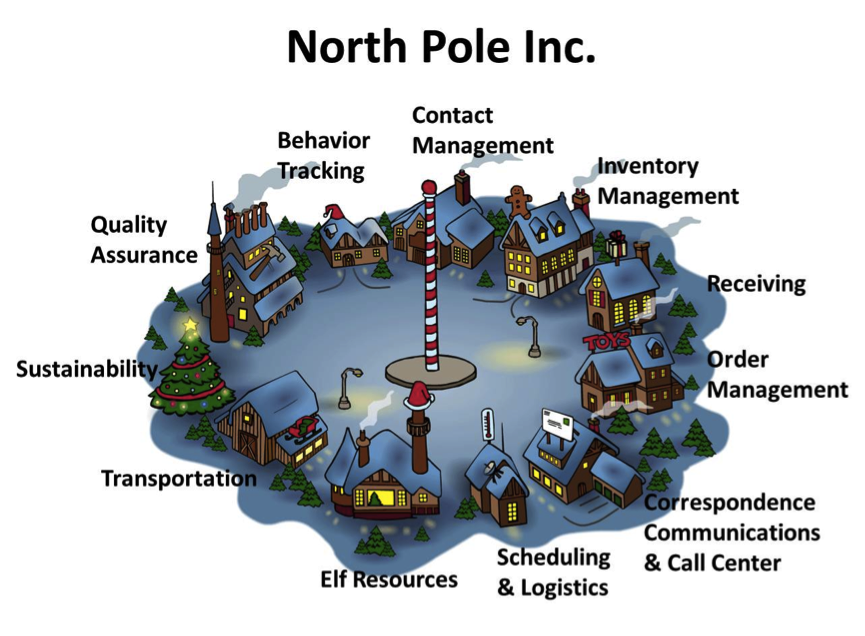Three Ways How Santa Claus Uses Big Data this Holiday Season

The holiday season operation is a big deal for Santa Claus. Getting the wide range of presents to kids all over the world is a complex operation that needs to be carried out within just a few days. Of course, nothing can go wrong, as that would significantly depress kids and their parents. Fortunately he can turn to Big Data to drive his different operations, which range from personalization of presents, inventory management and of course elf resources. As we don’t have access to North Pole Inc. lets have a look at how major retailers use Big Data this holiday season:

Image: North Pole Inc. via Gartner
Santa Claus will have a lot of shopping today this year. Forrester expects that online sales alone will reach $89 billion this holiday season. Retailers will have to do what it takes to be ready for this massive online demand and ensure that Santa Claus can find what he is looking for. Big Data analytics of course will help online retailers, as well as offline retailers, in recommending the right products for the right customers at the right moment.
Omnichannel Personalization
Omnichannel personalization is one of the most powerful tools online retailers can turn to. Creating a data-centric, single view of the shopper allows etailers to deliver the most relevant experiences across web, mobile and in store. Win.com, which is the #1 online wine retailers is a great example of how omichannel personalization drives revenue.
Offering thousands of wines to millions of customers across different channels requires deep knowledge about your customers. By combining data sources such as a shopper’s current browsing behaviour, geographical location and their online shopping behaviour they are able to show products to their customers they would not have considered otherwise, resulting in among others a 15% increase in order value.
Inventory Management
Big Data enables retailers to stock their warehouses intelligently. This will ensure that stores across the country are always stocked with the right products and the right amount of these products. Based on a variety of data sources such as buying patterns, weather conditions, market conditions or trends on social media, retailers can predict which products will be required where. Sensors, such as RFID tags, are also already widely used by retailers, online and offline.
Of course, not only inventory management can be improved, but also delivery management can be improved significantly. As can be learned from the case of UPS, weather data, traffic data, truck location data and other kinds of data sets can optimize delivery management in real time.
A Venezuelan supermarket has turned to Big Data to get insights in their inventory management worth $ 20 million. They are now analysing their 6 Terabyte of product and customer data to be able to review in real-time their inventory levels, store sales and costs of goods. This enables them to understand which products are selling better, which products are most profitable and which promotions are successful.
Walmart goes one step further. They are using their social genome to know who their customers are, what they say online and they adjust their offering based on these, as well as multiple other data sources such as the weather. A well-known case is the case of Strawberry Pop-Tarts. Walmart, recording every purchase by every customer for future analysis, noticed that when there was a hurricane warning the Walmart stores in the affected area would increase the sales of Kellog’s Pop-Tarts. Store managers were told to order extra and place the Pop-Tarts near the entrance during hurricane season.
Retailer Resource Management
Large retail chains employ many employees and Big Data can be used to improve their resource management. Retailers can use Big Data to monitor employees’ performance in real-time and take action if required. The data can also reveal top performers as well as workers who are unhappy in their job. Big Data can therefore improve employee engagement across a wide range of variables.
But that’s not all. Big Data can also be used to combat employee theft. Retailers can lose a lot of money due to employee theft and most of the time this is difficult to stop. However, Ontario-based Compass Group Canada, an owner and operator of more than 2,000 food service locations, like Tim Hortons, Subway and Starbucks is applying Big Data in a new way to combat theft. Of course they have camera’s in each of the service locations, but monitoring the millions of hours of video is undoable. Therefore they have developed a self-service analytics system. This system collects data from point of sale systems, enterprise resource planning system, employee time and attendance software and inventory management systems and combines them to find disparities. Once a discrepancy is found, the corresponding video system is analyzed to see what has happened. Thanks to this system, the company can better trace and therefore stop theft.
Retailers can benefit from Big Data in multiple ways and these three use cases are only the beginning. In the coming years we will see more examples of retailers using Big Data to improve their quality, improve contract management or improve their marketing and communications.





